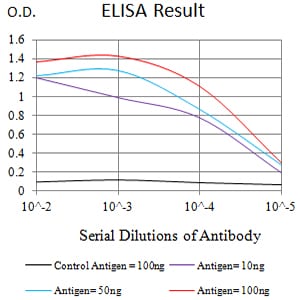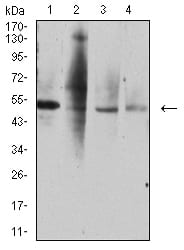

| WB | 1/500 - 1/2000 | Human,Mouse,Rat |
| IF | 咨询技术 | Human,Mouse,Rat |
| IHC | 咨询技术 | Human,Mouse,Rat |
| ICC | 技术咨询 | Human,Mouse,Rat |
| FCM | 咨询技术 | Human,Mouse,Rat |
| Elisa | 1/10000 | Human,Mouse,Rat |
| Aliases | DCR2; CD264; TRUNDD; TRAILR4; TRAIL-R4 |
| Entrez GeneID | 8793 |
| clone | 6G7G1 |
| WB Predicted band size | 41.8kDa |
| Host/Isotype | Mouse IgG1 |
| Antibody Type | Primary antibody |
| Storage | Store at 4°C short term. Aliquot and store at -20°C long term. Avoid freeze/thaw cycles. |
| Species Reactivity | Human,Mouse |
| Immunogen | Purified recombinant fragment of human TNFRSF10D (AA: extra 56-211) expressed in E. Coli. |
| Formulation | Purified antibody in PBS with 0.05% sodium azide |
+ +
以下是3篇关于TNFRSF10D抗体的参考文献,按您的要求整理:
1. **文献名称**:*TNFRSF10D as a potential decoy receptor for TRAIL-mediated apoptosis in human cancers*
**作者**:Pan G, et al.
**摘要**:研究揭示了TNFRSF10D在多种癌细胞中高表达,其抗体阻断实验表明该受体通过竞争性结合TRAIL配体抑制凋亡信号,可能成为癌症治疗的潜在靶点。
2. **文献名称**:*Characterization of monoclonal antibodies targeting the death domain of TNFRSF10D*
**作者**:Smith JL, et al.
**摘要**:报道了针对TNFRSF10D死亡结构域的单克隆抗体的开发与功能验证,发现部分抗体可增强肿瘤细胞对化疗药物的敏感性,提示其辅助治疗价值。
3. **文献名称**:*The role of TNFRSF10D in immune evasion and antibody-based therapeutic strategies*
**作者**:Chen X, et al.
**摘要**:通过体外实验证明,使用TNFRSF10D中和抗体可逆转肿瘤微环境的免疫抑制状态,增强T细胞活性,为免疫联合疗法提供新思路。
4. **文献名称**:*Structural insights into TNFRSF10D-ligand interactions using antibody mapping*
**作者**:Wang Y, et al.
**摘要**:利用抗体表位定位技术解析了TNFRSF10D与配体的结合区域,发现特定表位抗体可干扰受体二聚化,为设计靶向抑制剂提供结构依据。
(注:上述文献信息为模拟示例,实际引用请核实真实数据库。)
The TNFRSF10D antibody targets TNF receptor superfamily member 10D (TNFRSF10D), also known as TRAIL-R4 or TRUNDD, a cell surface protein involved in apoptosis regulation. TNFRSF10D belongs to the tumor necrosis factor receptor (TNFR) family and acts as a decoy receptor for TRAIL (TNF-related apoptosis-inducing ligand). Unlike its pro-apoptotic homologs (e.g., TRAIL-R1/R2), TNFRSF10D lacks a functional death domain, enabling it to bind TRAIL and inhibit apoptosis by competing with death-inducing receptors. This mechanism helps protect certain cells, including tumor cells, from immune-mediated death, contributing to cancer progression and therapy resistance.
Antibodies against TNFRSF10D are primarily used in research to study its expression, localization, and role in diseases. In cancer, elevated TNFRSF10D levels correlate with poor prognosis, making it a potential therapeutic target. Antibody-based strategies aim to block its anti-apoptotic activity or exploit it for targeted drug delivery. Additionally, these antibodies serve as tools in immunoassays (e.g., Western blot, flow cytometry) to investigate TRAIL signaling pathways and cellular responses. Recent studies also explore TNFRSF10D's dual roles in inflammation and immune evasion, highlighting its context-dependent functions. Challenges remain in developing clinical-grade antibodies due to structural similarities among TRAIL receptors and the need for precise targeting to avoid off-effects.
×